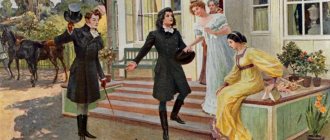- Essays
- About family
- What should a family be like?
Every person begins his life in a family. The process of human socialization begins with the family. Family members are your closest support people throughout your life. All families are completely different, but at the same time each is somewhat similar. What should a strong family be like?
First of all, all family members must find complete mutual understanding. It often happens that brothers and sisters do not like each other, and there is competition between them for the attention of their parents. The only people to blame for this are the parents who failed to explain to their children that they love them equally, so there is no need to compete. You can often see a lack of mutual understanding between the child and parents. Parents are to blame here too. The child grows up and faces certain problems, but the parents must understand the child and explain to him how to act in a given situation.
To avoid secrets and understatement between family members, you should never ignore each other. Often parents forget about their own children and think only about their own problems. It’s so easy to lose a child’s trust and miss the moment when the child gets into the wrong company and contacts the wrong people. Then it is almost impossible to help the child.
A family must be loving. Some parents do not show their love to their children, so the children do not know how to love. Such children will behave in the same way towards their children in the future. Parents must show their love to their children.
Many children face the problem of lack of support from their parents. Such children grow up unsure of themselves, even if they are the most talented children. Children always need to feel the support of their parents.
Family is the most important thing a person has. Everyone should value the people they call family. The concept of a “proper family” does not exist. Each person should have their own approach. Each family has its own customs and traditions, which makes them unique. However, there is a concept of a “happy family”. A happy family should be loving, understanding and forgiving.
Male gaze
What should an ideal family be like, according to representatives of the stronger half of humanity: 10 components.
- Delicious daily breakfasts, lunches, dinners.
- Regular sex, no headaches for the wife.
- A cozy, tidy home and, as a result, an economic spouse who does not shy away from housework.
- The wife's loyal attitude towards friends; adequate response to friendly gatherings.
- Her loyal attitude to her husband’s hobbies and hobbies (letting go fishing, hunting or going to the sauna without a quarrel, no scandals after purchasing a useful thing like a fishing rod, car radio or naturalist’s encyclopedia).
- Love for one sport and/or genre of films/music (or at least the absence of disputes due to divergent tastes).
- The absence of daily hysterics and scandals out of nowhere.
- A beautiful wife who does not neglect herself after the wedding.
- A good mother-in-law who does not interfere in the personal life of the spouses.
- Lack of “everyday” gifts like a hammer, drill, razor, etc. from the wife.
Animal look
Some people consider their pets to be full members of the family. Dogs and cats, by the way, also have their own view of the ideal family model, so their opinion should also be taken into account. So, if pets could talk, they would most likely express the following wishes.
- Ideal feeding: the more often the better. Owners should forget about cheap dry food and start cooking for their pets (fish, meat, sausage, etc.). Cooking involves bringing the pieces into a chopped form.
- Sleep anywhere. The ban on jumping on beds, tables and clothes promises controversy.
- Caress at any time.
- March delivery of cute females/males on demand.
- Permission to use the toilet in public places such as the sofa, corners and shoes.
- Breeding mice (personal desire of representatives of the cat family).
- Walking for dogs, no washing for cats.
- Daily games of “hunting” for a laser, a piece of paper, a fake mouse, etc.
- Prohibition on touching and seeing other people's pets.
- Communication in one language (animal, of course).
Short mini essay Kokoy should be an ideal family for 6th grade
A family, no matter how small or large, is ideal for me when love, happiness, joy, trust, respect, understanding, care, calm, attention, comfort, protection, and warmth reign in it. Ideal when children are bright-eyed, and parents are happy because they have such children, when grandparents are looking forward to their grandchildren, and grandchildren dream of being with their grandparents as soon as possible.
In an ideal family, no one remains misunderstood, because children hear their parents, and parents hear their children. Everyone in this family stands up for each other. The ideal family for me is when returning home is a joy.
What will the family of the future be like and why the naturalness of traditional marriage is a myth
It is often believed that traditionalism is forever marked with a sign of quality and concreted in the experience of generations. Often the equal sign between traditional and good is put “by default”. But it’s worth remembering at least that forced marriages in the Caucasus are a tribute to tradition, and equality ceases to be obvious.
Another “iron” argument is naturalness; arguing with it is as difficult as arguing with a parent’s “mom said”, that is, almost impossible. The family is considered to be the natural embodiment of our natural instincts.
In fact, in any conversation about traditional values, the long history of marriage relations is taken out of the equation - with polygamy, polygamy (more rarely, polyandry), arranged marriages (or more precisely, at the will of the parents), the complete lack of rights for women and other delights of the traditional way of life.
Love turned out to be the central element of family relationships not so long ago. Consider Montaigne’s statement: “A successful marriage, if it exists at all, rejects love and everything that accompanies it; he tries to compensate for it with friendship.”
Nowadays, arranged marriages exist, but are regarded with contempt, and the family is extolled as a union of two loving people. In Montaigne's era, marriage was considered reliable to the extent that it excluded love.
Marriage acquired its usual form only in the last century. Nuclear family: a heterosexual couple with one or two children is a 20th century phenomenon.
Heterosexual relationships have always been built around social institutions associated with childbirth - procreation, inheritance, transfer of property. As part of the social order, marriage was based rather on rational calculation, excluding such an anarchic element as love. The main goal of the family in such a situation is to maintain social order and the demographic policy of the state. Autonomy of feelings goes against his interests.
In non-state societies, people live in complex tribal structures that are far from the usual monogamous family. Couple relationships, which Western culture conceives of dating back to Adam and Eve, were not the norm for a long time, and forms of marriage have always differed between cultures.
Polygyny was found in Ancient Egypt, Mesopotamia, Iran and India, and continues to this day in Muslim culture. Polyandry - that is, polyandry - although much less common, still occurred. For example, in Hindu and Buddhist communities in the Himalayas, it was traditional for several brothers to marry the same bride. The custom served purely practical purposes: it allowed the brothers to keep the inherited land, and not to split it between all relatives into tiny parts. The tradition lasted until the 20th century and came to an end only when the economy made it possible to abandon it.
In the Old Testament there are references to this phenomenon more than once. King Solomon had 700 wives and another 300 concubines. King David's track record was not so impressive: it accurately includes 18 women of different status - wives and concubines. The forefathers of the Jewish people Abraham and Jacob were no exception - both of them were polygamists. The Bible also spells out the principle of levirate - it makes polygamy mandatory for those whose brother left a widow without an heir.
In Ancient Greece, polygamy was considered an unworthy barbaric custom, but “going to the left” remained an absolutely legitimate practice. Legal marriage served purely for procreation.
At the same time, a culture of heter harlots openly existed. It was not a simple analogue of prostitution. Wives did not have the right to vote and were subordinate to their husbands in everything. The status of a hetaera gave a woman independence and her share of “publicity.”
Homosexuality for the Greeks was the norm, if not an institutional practice. It was of a pedagogical nature: erotic relationships between a mature man were permissible only with a young man, often his student. Bisexuality was also the norm in Rome.
Tightening of the family code comes to replace pleasures already in the Middle Ages. Childbirth is at the center of the church's sexual policy. Family relationships are entirely subject to demographic demands. Abortion was equated to murder, and coitus interruptus was considered a terrible sin. This prohibition dates back to the biblical episode associated with Onan. It is usually interpreted as the inadmissibility of masturbation, although what we are talking about here is, in fact, a refusal to fulfill the custom of levirate.
“And Judah said to Onan: Go in to your brother’s wife, marry her as a brother-in-law, and restore seed to your brother. Onan knew that the seed would not be his, and therefore, when he went in to his brother’s wife, he poured out [semen] on the ground, so as not to give seed to his brother. What he did was evil in the sight of the Lord; and He slew him also.”
Relationships begin to be built around the act of procreation. Pleasure becomes a random bonus, or is even completely excluded from the family.
The “modern” type of state and city appears in the Middle Ages. The body, according to medievalist Jacques Le Goff, becomes the central metaphor of his institutions. It is, as Michel Foucault described it, “subject to relations of power.” The body is inscribed in politics and controlled for state purposes.
This control is not only punishment, but also an “investment” in life and fertility. There is little place for love in this scheme, and the family in it serves utilitarian purposes. Conception was considered the sole purpose of sex. Even within the framework of a legal marriage, “too ardent love for one’s wife” remained “adultery,” as the clergy argued.
The bond of marriage was supposed to be a stop signal for desire - especially the desire of a woman. What was secretly allowed to men was taboo for women, primarily because of her reproductive function. Only in the second half of the twentieth century did attention shift from the birth of children to relationships within a couple.
In addition, for a long time, marriage remained more of a diplomatic decision: it was concluded in order to establish connections beneficial for the families of the bride and groom - to conclude a truce or a strategic alliance, to straighten out the affairs of an ailing family, or to take possession of new property. Misalliances were not allowed, and few people took into account the opinions of those getting married - especially the bride. If a man could marry for love, then a woman found herself in a much more vulnerable position: both legally and financially she depended first on her father and then on her husband.
For example, American women could not own property until the mid-19th century: even a working woman’s income belonged entirely to her husband.
The act of “transferring” a girl from her father’s house to her husband was not much different from the culture of exchanging women in primitive tribes. As anthropologist Claude Lévi-Strauss noted, marriage was a way to establish diplomatic ties between them. The woman in this scheme was a figure of exchange. Love began to penetrate marriage at the end of the 18th century. England took a turn towards marital love during the era of Queen Victoria.
However, marriage for love remained in the status of work-in-progress for a long time: even without finding “her soul mate,” the woman was forced to get married. She was pushed to do this by public opinion and the lack of equal rights with men: she inevitably needed patronage, at least until women found their voice in the suffragism movement.
The model that is familiar to everyone: a man as a breadwinner, a woman as a housewife and several children - this is a nuclear family, which is usually called a traditional one. But the family, like any social institution, does not freeze in time and space; rather, on the contrary, it changes along with society and depends, first of all, on the economy. The nuclear model was a product of the industrial age. The pre-industrial era was characterized by large families: people lived on the land, and it required many hands to cultivate it. The industrial transition with all that it entails - the development of cities, plants and factories - required greater mobility from people. Gradually they move to the city, where an accelerated pace of life awaits them, a Ford assembly line and “small cars” instead of their native hectares of land. The structure of the family inevitably changes: young couples separate from their parents and are limited to a few children, different generations stop living together, and the family becomes smaller.
Behind the idyllic facade of the 50s there was an unattractive underside: the “housewife syndrome” - depression and nervous breakdowns of women literally locked in a “golden cage” - was ubiquitous.
However, trying to return to this model can be about the same success as persuading someone to switch from a car to a horse-drawn cab. That is, you can talk as much as you like about the environmental friendliness of this method of transportation, but it is impossible to stop progress, just as it is impossible to turn back time.
This does not mean that it is time to sing a dirge for the family: the industrial era did not eradicate large families, but they have ceased to be the universal norm. The era with the prefix “post” has generated a huge space of choices: the nuclear model may be only one of them, but not a universal universal. To return it to its dominant role, it would be necessary to freeze the development of humanity. The nuclear family was the ideal solution for a mass and centralized society.
As the traditional way of life disintegrates, society becomes increasingly atomized. Where there is individuality and freedom of movement, diversity also appears - the one-size-fits-all norm loses its power.
The family ceases to be an economic unit of survival. If half a century ago it was an urgent need: for example, French women received the right to work without their husband’s permission only in 1965, and running a household alone was difficult before the invention of the multicooker and washing machine - now the practical component of marriage is increasingly disappearing. People can live alone.
Since the second half of the twentieth century, the family has ceased to be child-centric: the focus of attention has shifted from children to relationships between partners.
The baby boom of the post-war 50s gave rise to the unconditional value of a child: even after experiencing a serious relationship crisis, parents did not divorce for the sake of their children; for their sake they could give up their careers. The student riots of 1968 and the sexual revolution, the era of eclecticism and the collapse of the old social order - this is also a crisis of the bourgeois family.
Individualization means that a person is no longer ready to sacrifice himself - career, success and even momentary pleasure - for the sake of the demands of society or the state.
According to psychologist David Elkind, the family is becoming adult-centric: parents are ready to move to another city for the sake of a career, even if this is not the most comfortable situation for children, or they may simply divorce - raising a child alone becomes economically possible. In addition, the development of contraception gave rise to a childfree culture.
The decision to exchange rings is increasingly becoming a free choice. We can remain single or find partners - one chosen one or leave the relationship open.
The other side of the coin is the tyranny of choice: endless anxiety about the correctness of our decisions.
Romance in the 21st century is largely serial monogamy: periodically changing partners instead of one marriage for life. Faced with endless choices, from the varieties of cheese on the department store shelf to emotional attachments, we scramble to find the best.
Psychoanalysts note the inability of modern people to have long-term love relationships. It seems that in an atomized world, the defense mechanisms of neurotics and fear of intimacy have been transferred to society as a whole. What changes led to this, and most importantly, what is behind it?
“The culture has finally turned into a narcissistic one, much less concerned with love and desire, and much more with the search for quick gratification,” as psychoanalyst Renata Salecl writes about it. Or have we become so rational that we reject the myth of the “one and only”? But the fact remains that romantic relationships are changing their format, and people are less and less in a hurry to tie the knot, just as they are not striving to take possession of property or gain stability.
“Lack of obligations is a new wave in relationships,” Salecl characterizes modernity. The reason for this is the shift in age boundaries.
The question “what will I become when I grow up” ceases to be shameful even at thirty years old.
Traditionally, growing up was marked by mastering the main social roles: employee, spouse and parent. Millennials spend much more time studying, finding themselves and choosing a partner. This is a reaction to a new reality: we have too many ways to live life to know for sure the right one by the age of twenty.
We have the opportunity to change jobs or place of residence overnight (even to another country), and the demand for new professions is born at such a speed that, while receiving education, we do not know whether it will be relevant by the time the diploma is issued. A person experiences uncertainty, and following this, he postpones important decisions. In addition, the type of socialization is changing: it is increasingly moving to the Internet. Virtual dating doesn’t just replace real ones: researchers notice that the ability to empathize on the Internet also decreases. A person immerses himself more in himself than builds mature emotional contacts.
To revive 1950s marriage would be to “force women back into the kitchen” and “to ban contraception and sex biology research that promotes female independence and extramarital sex, thereby weakening family ties,” as sociologist Alvin Toffler wryly noted.
To do this, it is necessary to reduce the level of economic development so that people simply cannot survive on their own. Sounds too much like something out of a dystopia to be true. However, this is exactly how the logic of the conservative turn works. The mobilization of pro-lifers, the exclusion of LGBT people from marriages, the “law on the promotion of non-traditional family relationships” and the conservative rhetoric about large families that has penetrated into schools is an attempt by the state to throw society back to a point that it has already passed.
By playing against grassroots modernization—that is, the aspirations of society itself—the state is doomed to failure. The more the state “insists” on official marriages, the more often people do not enter into them at all.
As the family transferred its functions to other institutions: education to the school, health care to hospitals, its utilitarian meaning gave way to love. Of course, love is a very fragile basis for a family, but now it is perhaps the only justification for the union of two people.
Where there is love, the state has nothing to do - autonomous, if not anarchic, this feeling does not fit into state normativity. That is, the state can prevent homosexual marriages as much as it wants, but it will never prohibit love, it can offer maternal capital and increase patriarchal rhetoric, but it will not force people to change their personal vector of development.
What kind of family will replace the nuclear one? Will the stamp in the passport be replaced by contracts regulating the property relations of partners? Or will marriage survive as a symbolic gesture? The question is not even about the form of partnership, but about the variety of options.
The most certain thing that can be assumed is that over time we will not find a dominant family model, but instead a variety of individual trajectories. Guest marriage as an effect of the accelerated pace of life, individualism and increasing economic independence from others, mono- or polyamory, living with a partner of the same or opposite sex, and even refusal of romantic relationships - the palette of choices is becoming wider, as is the very understanding of family. The struggle for gender equality, new values, blurring the boundaries of personal and work space - all this changes the nature of our relationships.
No one is saying that the family will die; rather, it will change beyond recognition, when only the private will remain at its epicenter - that which has been pushed to the periphery for a long time.
Essay One day in the life of an ideal family
Morning. Everyone is running around screaming that they are late. There's a long line to the bathroom because my sister takes so long to clean up her mess. Meanwhile, mom had already set the table, and the smell of hot milk porridge spread throughout the apartment. Let's eat. Everyone left the house together. Some go left, some go right, and I go straight to school.
The lessons are over. I’m in a hurry to get home, I need to quickly restore perfect order, maybe then my parents won’t notice the entry in my diary that I behaved badly in class and didn’t listen to the teacher. My brother is already cleaning the house; he probably also had some adventures at school. We're done. He received it from his brother for writing in his diary, nothing, dad will sort it out with him in the evening.
Evening. Mom, dad and sister returned from work. They are heatedly arguing about something. Doorbell. Grandparents with something tasty, probably grandma’s signature pancakes. I love Friday.
Dinner. Everyone is arguing heatedly again. Grandfather is the most indignant, grandmother tries to calm him down. Then I decided to take revenge on my brother and told his secret to my dad, mom, and basically everyone sitting at the table. Silence. Everyone is looking at me and my brother. My brother blushed, for some reason I felt very ashamed. Laughter.
Let's eat. My brother washes the dishes, I clear the table, my mother and sister manage us. Then a long lecture from grandfather and father about the benefits of studying, what prospects open up for an educated person and how knowledge will be useful in life. My brother and I thought about it and firmly decided to study.
Everyone sat down in front of the TV. We watch a movie, although we spend more time chatting than watching. It's time to sleep. He hugged and kissed everyone and wished them pleasant dreams. Lay down. Thought...
An ideal family, what is it like? A large, friendly, cheerful family built on love, respect and understanding, in which everyone cares about each other, worries about each other, and trusts each other. I came to the conclusion that my family is ideal, and even though we argue, swear, get offended sometimes, can be cunning (especially my brother and I) or be mischievous, we all understand each other perfectly, and we all simply cannot imagine ourselves without a family.
He smiled. Fell asleep.
Other essays: ← Grandma makes me eat porridge in the morning ↑ Family Why enmity arises between relatives →
How to create an ideal family
The answer is obvious: take into account all the wishes of each party. Of course, it is clear that not all the points described above can be accomplished, some are almost impossible, but you can find or try to find a compromise.
Another, simpler and actually effective option is this: gather all family members and talk frankly; ask what the very concept of “ideal family” means for each specific person, and then decide how it can be created. For it to work, everyone must want it. You won’t be able to create an ideal family secretly and on your own; you’ll only ruin your nerves and end up with nothing.
Bottom line
An ideal family is an abstract concept that means peace and happiness in the relationship between spouses and harmony in their lives. For some, a family is considered ideal if it has a small but cozy apartment on the periphery and two charming children, while for others it will be difficult to live even in a huge, luxurious cottage on the seashore. To each his own. So, decide what an ideal family means for you, write everything down point by point for better perception, understand what you lack for happiness, and create your own perfect world together with your husband/wife.
Mini essay No. 1
An ideal family is people who understand each other without further ado. If parents experience real feelings, it is noticeable even to the naked eye. The tenderness with which dad treats mom, their general attention to the children. In such an environment, quarrels and conflicts are impossible. Relatives should strive to spend all their free time together. Even if someone’s mood deteriorates, a loved one tries to help cope with the difficulties that have arisen.
I would really like my family to be like this. But in order for the relationship to be strong and reliable, it is necessary that each of the relatives wants to understand the people around him. And this does not always work out, because everyone is busy with their own affairs and worries.
Why?
- Why doesn’t happiness and peace reign in the house?
- Why can't people reach mutual understanding?
- Why does life together sometimes turn into real hell?
- Why is there everything that seems to be needed for happiness, but the family still cannot be called ideal?
- Why can’t you transform a family from ordinary to ideal in a day or two?
- Why did a person seem one thing before marriage, and then become another?
- Why do thoughts about divorce arise from time to time?
- Why is everything happening like this?
Unfortunately, there is no answer to these questions, but they all relate to the topic under discussion, and the main - not the only correct, just the main - reason for all troubles is misunderstanding and the lack of some kind of connection between close people. Without these components, real, sincere family happiness cannot be achieved.







